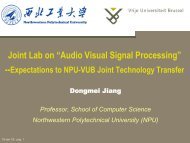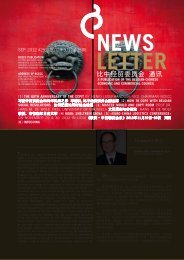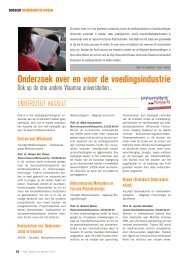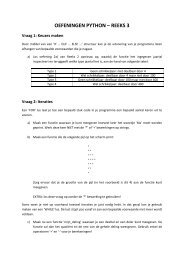least squares theory and design of optimal noise shaping filters
least squares theory and design of optimal noise shaping filters
least squares theory and design of optimal noise shaping filters
Create successful ePaper yourself
Turn your PDF publications into a flip-book with our unique Google optimized e-Paper software.
Verhelst <strong>and</strong> De Koning Least Squares Noise Shaping<br />
is the additive quantization distortion at the output <strong>of</strong> the<br />
<strong>noise</strong> <strong>shaping</strong> requantizer. Subtracting equation (2) from<br />
(1), one finds that<br />
� Þ � À Þ � Þ (3)<br />
The requantization error � Ò therefore has power spectrum<br />
È� � �� �� À � �� � È� � ��<br />
(4)<br />
As we can see, the quantizer’s error spectrum gets shaped<br />
by a <strong>noise</strong> <strong>shaping</strong> filter that depends on the error-feedback<br />
filter À Þ .<br />
Note that this result was obtained without reference to the<br />
quantizer Q. Therefore, it applies for any type <strong>of</strong> quantizer,<br />
whether it is dithered or not, linear or nonlinear,<br />
whether it uses rounding or truncating,. . .<br />
In order to achieve minimal audibility <strong>of</strong> the requantization<br />
error, À ��� can be <strong>design</strong>ed to minimize the total<br />
amount <strong>of</strong> perceptually weighted <strong>noise</strong> power Æ Û:<br />
ÆÛ �<br />
� �<br />
�<br />
È� � �� Ï � �� (5)<br />
Ï � is a perceptual weighting function that approximates<br />
the relative audibility <strong>of</strong> <strong>noise</strong> power at the different<br />
frequencies.<br />
If a properly dithered quantizer Q is used, the power spectrum<br />
<strong>of</strong> the quantization error � Ò will be constant<br />
such that eq. (4) then reduces to<br />
È� � �� �� É (6)<br />
È� � �� �� À � �� � � É (7)<br />
1.2. The Gerzon-Craven <strong>theory</strong> [7]<br />
Let us assume that the desired shape � ��� <strong>of</strong> the error<br />
spectrum is given. Thus, from eq. (4), the <strong>noise</strong> <strong>shaping</strong><br />
filter À Þ has to be determined such that<br />
� À � �� � È� � �� �«È� � ��<br />
(8)<br />
with minimal «. In principle, there are several <strong>filters</strong><br />
À Þ that satisfy eq. (8); the different solutions correspond<br />
to <strong>noise</strong> <strong>shaping</strong> <strong>filters</strong> À Þ with a same power<br />
spectral shape <strong>and</strong> different phase characteristics. Based<br />
on information theoretic considerations, it was proven by<br />
Gerzon <strong>and</strong> Craven that the <strong>noise</strong> <strong>shaping</strong> filter À Þ<br />
that satisfies (8) with the smallest possible output error<br />
power is the filter that leaves the information capacity<br />
<strong>of</strong> the channel unaltered (maximum), <strong>and</strong> that this is attained<br />
when the filter is minimum phase.<br />
Therefore, it was suggested that a practical method to <strong>design</strong><br />
<strong>optimal</strong> <strong>noise</strong> <strong>shaping</strong> <strong>filters</strong> would be to use any<br />
filter <strong>design</strong> program to approximate the desired spectral<br />
shape <strong>and</strong> mirroring any zeroes that lie outside the<br />
unit circle (for reasons <strong>of</strong> stability <strong>and</strong> causality, all poles<br />
would already have to be inside the unit circle).<br />
x(n) x’(n)<br />
+<br />
-<br />
H(z)<br />
+<br />
-<br />
e(n)<br />
Psycho-Acoustic<br />
Model<br />
dither<br />
+<br />
Q<br />
y(n) = {<br />
x’(n)+e(n)<br />
x(n)+e’(n)<br />
Figure 3: Psychoacoustic requantization with timevarying<br />
<strong>noise</strong> <strong>shaping</strong> filter À Þ derived from a perceptual<br />
masking model<br />
1.3. Some <strong>noise</strong> <strong>shaping</strong> implementations<br />
Super Bit Mapping (SBM) [5] follows this suggested strategy<br />
<strong>and</strong> introduces a clever trick to <strong>design</strong> a minimum<br />
phase FIR <strong>noise</strong> <strong>shaping</strong> filter with a given power spectral<br />
shape.<br />
Note that in order to avoid delayless loops in Fig. 2, itis<br />
required that the FIR <strong>noise</strong> <strong>shaping</strong> filter can be written<br />
as<br />
À Þ �<br />
�<br />
Ò�<br />
� Ò Þ Ò � where � � � (9)<br />
It was observed in [5] that an Š� -order inverse LPC filter<br />
is minimum phase (guaranteed if obtained from the<br />
autocorrelation formulation [8]) <strong>and</strong> satisfies (9). Thus,<br />
the required minimum phase FIR <strong>noise</strong> <strong>shaping</strong> filter can<br />
be obtained by approximating the inverse <strong>of</strong> the desired<br />
<strong>noise</strong> <strong>shaping</strong> spectrum with an LPC synthesis filter <strong>and</strong><br />
inverting the result.<br />
In SBM-1, the desired <strong>noise</strong> <strong>shaping</strong> spectrum is taken<br />
to be the hearing threshold in quiet. Although SBM-1<br />
can be successfully applied to make the quantization error<br />
minimally audible in quiet, it could be preferable to<br />
use a spectral <strong>shaping</strong> that minimizes the audibility <strong>of</strong> the<br />
requantization error in the presence <strong>of</strong> the actual audio.<br />
As illustrated in Fig. 3, in SBM-2 the <strong>noise</strong> <strong>shaping</strong> filter<br />
is a time-varying filter that is <strong>design</strong>ed to approximate the<br />
instantaneous masking threshold <strong>of</strong> the signal. In order to<br />
avoid artifacts from abruptly changing error feedback <strong>filters</strong>,<br />
smoothing <strong>of</strong> the time-varying filter characteristics<br />
is applied in the autocorrelation domain.<br />
The <strong>design</strong> <strong>of</strong> À � �� by optimization <strong>of</strong> (5) with numeric<br />
optimization techniques has also been considered<br />
[2],[3]. As this is a rather difficult problem, only fixed<br />
<strong>noise</strong> <strong>shaping</strong> <strong>filters</strong> have been <strong>design</strong>ed in this way. Because<br />
the <strong>noise</strong> is obviously most audible in quiet fragments,<br />
the perceptual weighting function Ï � was ap-<br />
AES 22 Ò� International Conference on Virtual, Synthetic <strong>and</strong> Entertainment Audio 3






